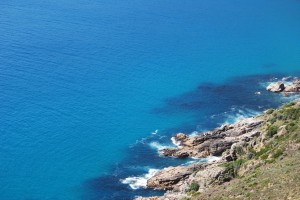CHAPTER < ONE - THE STORY OF LIFE ON EARTH CONTD.....
Beyond recorded history climatic shifts have been even more dramatic, exerting extreme pressures on all living things. Earth’s history reveals that ice ages have occurred in vast cycles of geological time: long periods of frigid cold known as glacials, when extensive ice sheets covered northern portions of the Earth, alternating with shorter spells of warmer weather known as interglacials. Believed to be influenced by changes in the Earth’s axial tilt and its orbit around the Sun, these climatic shifts caused habitats to shrink or expand, forcing animal species to adapt or migrate. When climatic changes occurred too quickly or extensively for species to adapt, or if geographical barriers such as mountain ranges prevented their migration, extinction was the inevitable result.
Our ancestors evolved and flourished when the world was in the grip of the last great Ice Age. It was a period of extreme and unstable weather. In the Northern Hemisphere freezing temperatures caused vast ice-sheets and glaciers to form, covering large parts of continents and the sea. Then over time warm interglacials melted the ice, forming great lakes.
 Retreating glaciers scoured the earth carving out deep fjords and lochs, and the sea level rose and fell in accordance with the presence or absence of ice. It was predominantly a frigid world populated by huge, hairy mammoths and woolly rhinoceros, sabre-toothed cats, cave lions, giant deer, and beavers as large as black bears. In the Southern Hemisphere the climate was not as cold or extreme as in the Northern Hemisphere. There was little or no snow but periods of dry cooler weather alternated with mild humid conditions. This caused the habitat to swing from grassland plains to lush forest, continuously changing the environment for many plant and animal species.
Retreating glaciers scoured the earth carving out deep fjords and lochs, and the sea level rose and fell in accordance with the presence or absence of ice. It was predominantly a frigid world populated by huge, hairy mammoths and woolly rhinoceros, sabre-toothed cats, cave lions, giant deer, and beavers as large as black bears. In the Southern Hemisphere the climate was not as cold or extreme as in the Northern Hemisphere. There was little or no snow but periods of dry cooler weather alternated with mild humid conditions. This caused the habitat to swing from grassland plains to lush forest, continuously changing the environment for many plant and animal species.
Globally the great Ice Ages presented a vastly challenging environment in which to exist. The repeated swinging from cold to warm and dry to wet placed enormous pressures on all living things of the time, forcing adaptation in the face of sometimes-savage natural selection pressures. Migrating before the onslaught of ice, volcanic ash, sea or mud; adapting to fluctuations in a changing environment or risking extinction, the story of life on Earth is a story of quiet starts and sudden violent stops; of evolutionary dead ends and highways of evolutionary progress. All told within the context of the vast epochal cycles of Heaven and Earth. It is not a quiet, gentle planet that has cradled evolution but a restless world seething with instability. In the face of such enormous odds, life has flourished into a multitude of magnificent forms, the most bounteous of which is our own species, Homo sapiens sapiens, a species which started on an evolutionary side street but which has ended up building the highway!
Ice Age People
Unlike the Neanderthals, Homo sapiens neanderthalensis, which was a possible sub-species of Homo sapiens that existed alongside our ancestors in what is now Western Europe for a time, our forefathers were not physically adapted to the intense cold of the Pleistocene epoch. Instead of the short, stocky, muscular bodies of the Neanderthals, which were an important cold-adapted physical characteristic for conserving heat, and the large noses that warmed the air they breathed, our ancestors relied on behavioural flexibility in order to survive. As they spread around the world on foot and much later on rafts or in dugout canoes, they colonised every type of habitat on Earth, ingeniously adjusting their mode of living to the demands of their environment.
On the fiercely cold, empty, wind-blasted steppes of present-day Eastern Europe for example, Ice Age people adapted their way of life around the mammoth, provider of food, clothing, shelter and fuel. They built sturdy huts of mammoth bones covered with hides. The thick hairy pelts gave waterproof shelter and kept out the biting wind. Fat-rich mammoth bones were burnt in shallow pits to provide warmth in arctic temperatures and huge hunks of meat were roasted over mammoth-bone spits to provide food for these hardy hunter people.
During the long frigid months of winter, several families shared the warmth and companionship of the comfortable mammoth-bone huts together. With icy gusts of wind sweeping the bare plains and sub-zero temperatures freezing the ground around their huts into permafrost, the men spent their time swapping tales of the hunt and carving an assortment of tools and ornaments out of ivory. The women tended their children and sewed furs and hides together using bone needles and sinew to make boots, hooded garments and trousers for their families; richly decorating this warm clothing with small beads of mammoth ivory, shells and animal teeth.
Ice Age society was based on the principles of community and sharing, with especially food being shared out between the members of a band. The reasons for this were practical and in no way simply altruistic. Because a large body retains heat better than a smaller one, the bitter cold favoured survival of the biggest. Ice Age animals were therefore huge-bodied and a number of hunters were required to kill a beast and then carry its carcass back to the shelter.
This meant that a kill of reindeer or cave bear, woolly rhinoceros or bison, provided a considerable amount of meat, enough for all the hunters’ families. And although surplus meat was at times stored in pits dug into the permafrost, sharing food in times of plenty ensured that a family’s needs would be provided for when meat was scarce. Collective hunting and communal living were important evolutionary steps forward: co-operation of the band ensuring the survival of the individual. It was this cultural development more than any other factor that enabled Ice Age men, women and children to survive in a hostile environment.
It is staggering to think that ancestral families lived, loved, birthed, talked, laughed, worked, hunted, fought, slept, ate and died in a world so cold that at times more than one third of the land surface and a half of the surface area of the ocean were covered with ice kilometres thick. In that frigidly hostile environment at the height of the last great Ice Age, it is astounding that they were able to fashion a highly complex existence for themselves that included the warmth and companionship of other families, familial affection, artistic expression, self adornment, discussion and negotiation, behavioural rules, initiations, rituals and rights of passage, co-operative hunting and technological innovation.
And although life for Ice Age people was physically demanding, with men on average living for about 40 years and women averaging a lifespan of about 25 years, they evidently were able to achieve a life that included relative comfort and leisure, for their archaeological record shows that after their needs for food, shelter, clothing and tools were taken care of, there was time left over for art and music, dance and ceremony, learning and play.
Therefore, with no innate resources other than their own intelligence and the accumulated knowledge and experience passed down from generations of hunter-gatherers before them, there can be no doubt that our ancestors achieved the extraordinary. In the face of climatic extremes, and perhaps even because of it, they developed a highly complex social organisation. And by walking on land and sailing in primitive vessels on the open seas, they migrated to all four corners of the Earth except Antarctica, colonising every habitat that they found in their wanderings, and adjusting their way of life to accommodate the conditions of the environments in which they settled.
Stresses and Strengths
This thirst to explore, to know what lies beyond the horizon, and the courage to risk all in order to find out, is one of the defining characteristics of our species. It was the impetus for peopling the Earth and much later for travelling to the Moon. Over the millennia this has not changed. We are still a race of wanderers. Migrations have always shaped the conditions of humankind. They have also been a means of solving problems. Ice Age people marched before the encroachment of glaciers and bitter cold. Today more people flee from the onslaught of war, persecution, famine and environmental devastation than at any other time in the history of the human race.
 In those far off times there was space and natural places in which to wander. However, now at the beginning of the 21st Century, there is little space and even fewer natural places in which to roam. People are packed tightly into towns and cities, which are spreading like a virulent fungus over the face of the Earth. Governments, nationalism and borders have reduced the latitude for movement in modern-day societies and so an ancient survival mechanism has been cut off at the source. Running away has become less and less of an option in our congested world and, instead of fleeing in the face of pressures as our ancestors had always done, we have no option in this millennium but to learn to stay and solve our problems. In our favour are adaptability and behavioural flexibility: ancestral strengths that have been honed and tempered by time and the pressures of a great Ice Age.
In those far off times there was space and natural places in which to wander. However, now at the beginning of the 21st Century, there is little space and even fewer natural places in which to roam. People are packed tightly into towns and cities, which are spreading like a virulent fungus over the face of the Earth. Governments, nationalism and borders have reduced the latitude for movement in modern-day societies and so an ancient survival mechanism has been cut off at the source. Running away has become less and less of an option in our congested world and, instead of fleeing in the face of pressures as our ancestors had always done, we have no option in this millennium but to learn to stay and solve our problems. In our favour are adaptability and behavioural flexibility: ancestral strengths that have been honed and tempered by time and the pressures of a great Ice Age.
Masters of Change
Because the last Ice Age imposed such harsh environmental pressures and because of the need to endure and even overcome these conditions, ancient humans became masters of change. As we have seen in our evolutionary past, our ancestors mastered massive swings from glacial advances to glacial retreats. They enjoyed times of plenty when huge-bodied animals such as the woolly rhinoceros, musk ox, giant elk and woolly mammoth lumbered over icy terrains in numbers that allowed their own populations to grow. And they suffered scarcity when migrations of game failed to appear or when habitats changed so rapidly that game species, unable to adapt to climatic fluctuations, dwindled. In learning to survive, they adapted their food sources and they modified their needs for implements, fire, clothing and shelter according to the dictates of their erratic environments. By living in small bands and heeding the signs of nature, they were able to exist in a world that required constant adaptation.
 In a way our modern lives are no exception to this ancient code. We too are required to be masters of change. The difference is that the rate of change that we are experiencing is unprecedented in the history of our species. Like an old-fashioned movie that is fast-forwarded until the frames whiz by in a blur of impressions, our modern world has speeded up until many of us are left gasping by the effort to keep up. No other generation has been as time-conscious, date-aware and daily-pressured as our own. Our lives are lived predominantly on a treadmill of activity and sensation. We careen from home to work or school to home again in a whirlwind of action. But even as our own small personal lives have speeded up, so have many of the great tides and cycles that govern our lives: waves of population growth, technological innovation and cultural developments that have changed the horizon of Earth forevermore.
In a way our modern lives are no exception to this ancient code. We too are required to be masters of change. The difference is that the rate of change that we are experiencing is unprecedented in the history of our species. Like an old-fashioned movie that is fast-forwarded until the frames whiz by in a blur of impressions, our modern world has speeded up until many of us are left gasping by the effort to keep up. No other generation has been as time-conscious, date-aware and daily-pressured as our own. Our lives are lived predominantly on a treadmill of activity and sensation. We careen from home to work or school to home again in a whirlwind of action. But even as our own small personal lives have speeded up, so have many of the great tides and cycles that govern our lives: waves of population growth, technological innovation and cultural developments that have changed the horizon of Earth forevermore.
And so we have seen that it has taken thousands of millions of years of evolution for the story of life on Earth to reach this point. Our own story is a little more than two million years old – a brief sigh in the overall context of vast geological time. And yet our species, more than any other that has walked this planet, has developed in ways that are unique to the history of life. Unfortunately this development is now threatening the very life support systems that have always sustained it. At great risk are not only our own species but also every other species on the face of the planet.
In a sense we have done too well. Our efficiency has so far outpaced our collective wisdom that we have yet to see whether enlightenment will be able to stretch to 21st Century realities. North American Chief Dan George wrote, “We are as much alive as we keep the earth alive”. Our responsibility is vast not only to ourselves and other as yet unborn generations, but also to the other travellers that inhabit the earth, sea and sky. If we are to keep the Earth healthy and its wondrous diversity of living creatures intact, the future will have to be negotiated with a new vision, a new understanding and new solutions…